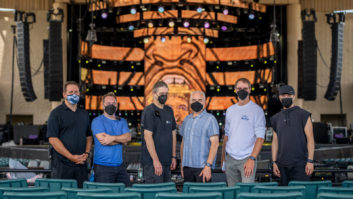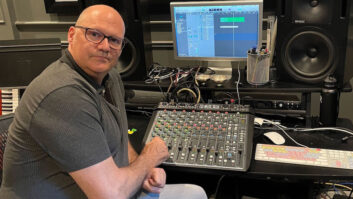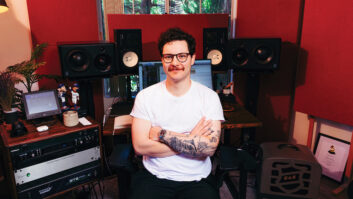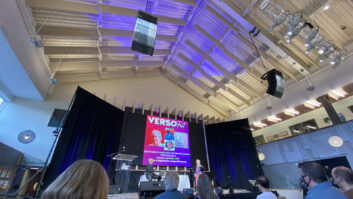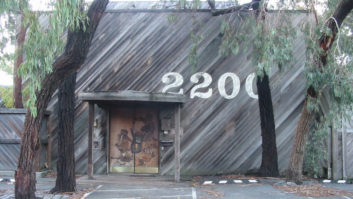What a difference a day makes. Jazz singer Dinah Washington first crooned about those “24 little hours” more than four decades ago, but to the members of the Dave Matthews Band, they sure rang true last fall.
The best-selling quintet’s whirlwind fourth quarter began predictably enough, with the initial incarnation of what was to be their latest studio album being recorded in the band’s home base of Charlottesville, Va., with veteran producer Steve Lillywhite at the board. It seemed like it was destined to be more of that riotously successful “same-old, same-old.” Lillywhite was also at the helm for the band’s previous three studio albums for RCA: Under the Table and Dreaming (1994), Crash (1996) and Before These Crowded Streets (1998). Their fourth musical union was well underway. In fact, a number of songs had not only been recorded, but were also performed during the band’s concert tour last fall.
But it now looks like DMB fans will have to wait for the inevitable box set somewhere up the road to hear any of those studio cuts on CD. That’s because, mid-production, the band met noted L.A.-based producer and self-described “studio rat” Glen Ballard — known for such smashes as Wilson Phillips’ self-titled release, Alanis Morissette’s monstrously popular Jagged Little Pill and No Doubt’s Return To Saturn, as well as for penning tunes for the likes of Michael Jackson, Quincy Jones, Brian Setzer and Aerosmith. So, all of a sudden, it was goodbye to Lillywhite and Charlottesville, hello big white bird, Hollywood and Conway Studios. Apparently, the switch happened that fast. But not before Matthews had time to grab his barely used electric guitar.
Given the circumstances — essentially starting the project over from scratch — it may seem like a minor miracle that Everyday hit store shelves on schedule at the end of February. Especially considering that the 12 songs on the album are all Ballard-Matthews compositions that weren’t started until after that cross-country hop. All told, the album took a scant nine weeks to record from start to finish, which isn’t a surprise to observers familiar with Ballard’s work. Asked about the torrid pace, he explains, “That’s how it should be. If you’re trying to capture the spirit of a project, it has to be done in less than a year.”
MAKING IT HAPPEN
The original plan was just to rework the songs that had been recorded with Lillywhite. But Matthews bagged that idea, for the time being anyway, and, instead, he and Ballard “wrote a song every day for two weeks and had the album demo’d by the time we went to the studio,” Ballard says, with Matthews on guitar and the producer on keyboards. This was a new approach to writing for Matthews, who apparently opted to work with Ballard, because he wanted a collaborator and — voila! — there was suddenly a window to work with this particularly successful one who’d sold more than 100 million records during his career.
Though the partnership was new, they clicked immediately and there was little writer’s block. “When Dave sits down to write, he writes. We did it like, bang,” Ballard explains. “We had a natural chemistry for each others’ technique and style. That’s rare, especially when we’d actually known each other for only six months at the time.”
Then it was time to record. While Hollywood might seem like a totally different environment to record in than a small southern town, Ballard says it was not so. “Conway is in the heart of Hollywood but offered a serene atmosphere that leant itself to getting more work done. We had a chef on-site and ate dinner at 7 p.m. every night. It was like halftime at a ball game where we’d review what we’d done. It was a healthy cycle that was about creating an environment where we all felt free, but challenged creatively. The fun thing is that we brought a great discipline and never got out of our comfort zone. When you make the progress we did, the more you hear it work and the more inspired you become. In the studio, we tried to bring our own vibe to it.”
When asked if anything went awry in the studio, he laughs softly. “I don’t think we failed at anything — we didn’t have time to.”
KNOBS AND WIRES
Ballard says that the album was finished so quickly, in large part due to the contributions of engineer Karl Derfler. “I think Karl is like a great wine,” he says. “He captured the terroir of the record. He’s a remarkable engineer and artist, himself, and brings one of the most comprehensive skill sets to his craft of anyone I know.”
We had a natural chemistry for each others’ technique and style. That’s rare, especially when we’d actually known each other for only six months at the time.
— Glen Ballard
The wine comment might be interpreted to infer that Derfler’s been at it for a while. Like Ballard, he’s been plying his wares for more than two decades. An independent engineer since 1977, Derfler has worked with General Public, the Verve Pipe, Rusted Root and No Doubt (with Ballard), among many others, and he has similar words of praise for the producer. “I think the big deal here was that Glen is more of a musician, being a protégé of Quincy Jones, and Dave wanted someone to collaborate with.”
As for the rest of the band, they seemed to love the change of scenery. “Their A&R guy, Bruce Fohlr, told me that that’s the best spirits he’s seen them in the studio,” Derfler notes.
The way the sessions worked was the band would listen to Ballard and Matthews’ demos, then expand on them. That meant the chance to try some new approaches in the studio, aside from Matthews jangling that new electric guitar. “Stefan [Lessard, bassist] used different basses, including one made from wood from the bottom of Lake Superior that was under the silt for 200 years,” Derfler says. “That gave it a unique tone that was used for a particularly great effect on ‘Sleep to Dream Her,’ as well as a variety of sounds that you don’t normally hear on a pop or rock record.
“We processed Boyd Tinsley’s violin heavily, especially at the end of ‘Dreams of Our Fathers,’ so it sounded like a string section,” he continues. “But the most unusual instrument was the contra-bass clarinet. Leroi Moore played it, notably on ‘The Space Between.’ It’s almost five feet tall and requires a very specific technique. It sounds like a foghorn, with nuances and much clearer harmonic properties.”
Still, the big news for DMB fans was Matthews going electric. While it’s unlikely to cause a similar stir to what Bob Dylan inspired at the Newport Jazz Festival in 1965, it’s still an event, to be sure. Derfler says Matthews used a rare Jerry Jones baritone guitar that was bequeathed to him by Ballard. A Strat owned by Ballard was the other main guitar used during the sessions. This was all to great effect, Ballard chimes in, noting that Matthews isn’t a “strummy” player. “Since I love his playing, the electric guitar expressed the notes more clearly and gave them more attitude.” Bassist Lessard also plays guitar on the album and mainly used his Modulus six-string. There were also Les Pauls and Telecasters on hand.
BEHIND THE GLASS
From a brief Derfler read before the band showed up in Hollywood, he learned that the DMB has always worked out the songs as a band in the studio. “That’s something else new about this experience,” he says. “Plus, Glen scored every song, so we had road maps. For an engineer, that’s a dream.” Then, using Pro Tools, “we worked out the arrangements in the computer, and each member overdubbed their parts individually. We employed Conway’s [SSL] J 9000 console, Neve outboard mic pre’s and a variety of vintage gear, which included two Telefunken V72 mic pre’s.”
The mic setup for Carter Beauford’s drums included an AKG D-112 and a Neumann U47 FET for the kick drum, an AKG 451 for the snare and hi-hat, Sennheiser MD-409s or B&K 4011s on the toms, and B&K 4011s and 4012s as overheads. For room sounds, Coles 4038 ribbon mics were used.
For Moore’s saxes, they mainly used an RCA 44 and occasionally an RCA 77. Boyd Tinsley’s violin was recorded direct using the Telefunken V72 mic pre with various Pro Tools plug-ins. Guitars were recorded through Ballard’s Matchless amp, and, occasionally, a Vox AC-30 and Marshall JCM900, combining sounds from the three amps for unusual effects.
“My main thing was to avoid using normal techniques like I would on pop records,” Derfler says. “The idea was to make something a little unusual. There are some spots where there is kind of a Pink Floyd vibe, where you subconsciously don’t know where things are heading. It affects you spiritually more than mentally.”
But that started with what Ballard and Matthews had already created by the time Derfler arrived for the sessions. “The wonderful thing was that the demos were so great, we used them as guides. They didn’t play together as a band on this album. It started with Carter’s drums, then the usual routine, with Stefen on the bass, Leroi on the horns and Boyd’s violin. Then Dave would sing and play his electric guitar.”
To borrow a phrase from an old Beatles album title, it sounds like maybe the DMB should have called this project “Something New,” because they messed with their own very successful formula. “And it’s easy to not mess with the formula,” Derfler acknowledges, “but we have enough formula.”
So, the Big Question is, after making the Big Move to work with Ballard, what’s the Big Difference? “My opinion is that you’ll hear more defined and concise music,” Derfler says. “I think Everyday sounds more that way than their earlier records. That has to do with going electric and the writing, which makes these songs different for the band.
“I could be wrong, but I had a feeling that they thought of this record globally. It has so many subject matters and goes from 4/4 to 9/8 time signatures. That’s very complicated for pop guys to even think about.”
IN THE CAN
Perhaps that’s why it’s so interesting to have a producer with Ballard’s musical pedigree producing the album. As he says, “I’m a musician first, and it’s important to be able to analyze what we’re doing. So having a score means I can hear exactly what’s happening.”
Derfler believes that Matthews just feels it and then intuits where it’s headed. “But I think his South African influences have given him the ability to hear rhythm in an interesting way. He comes up with some brilliant riffs in varied time signatures. The Beatles did the same thing. They didn’t always understand how they got there, either.”
As for Ballard’s contributions to Everyday, Derfler observes that it’s amazing to see a producer morph from one artist’s style to another’s. “I appreciate a producer with a wide palette. That’s Glen. He has that ability to bring out the best in people, but still let them have their own artistic voice or expression.”
That puts him in some elite company, in Derfler’s eyes. “To me, Glen, George Martin and Quincy Jones are in the same ballpark. Whatever you need done, they can do.”
Mark R. Smith has been a freelance writer for a decade. He hangs with his CD collection and his cocker pup, Dusty (as in Ms. Springfield), in Odenton, Md.

